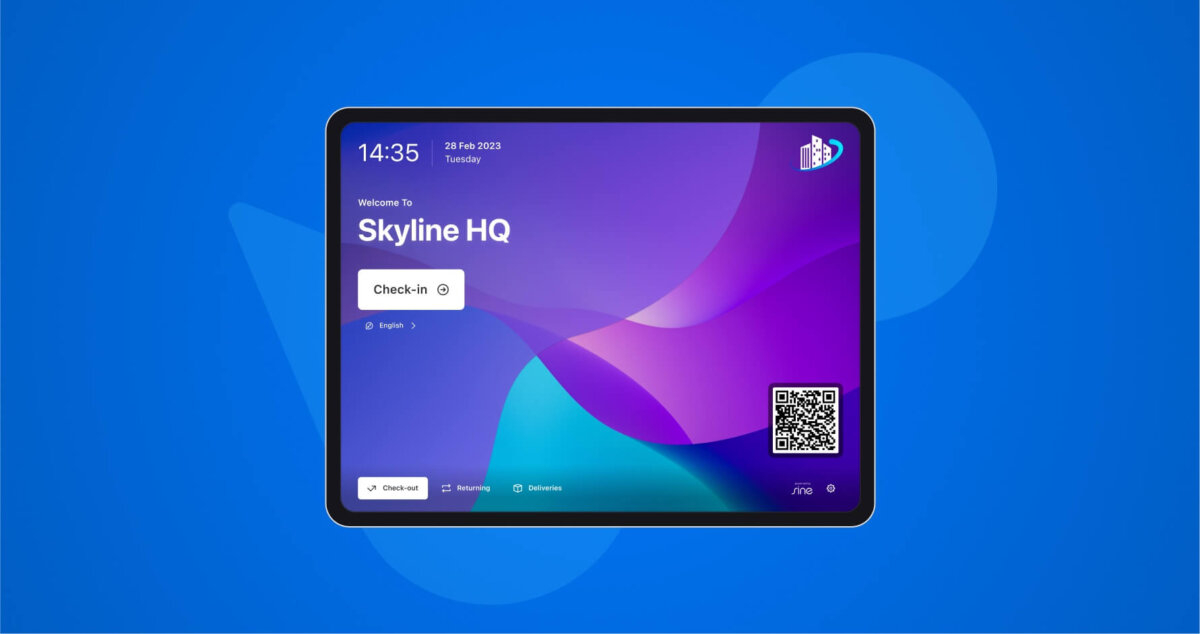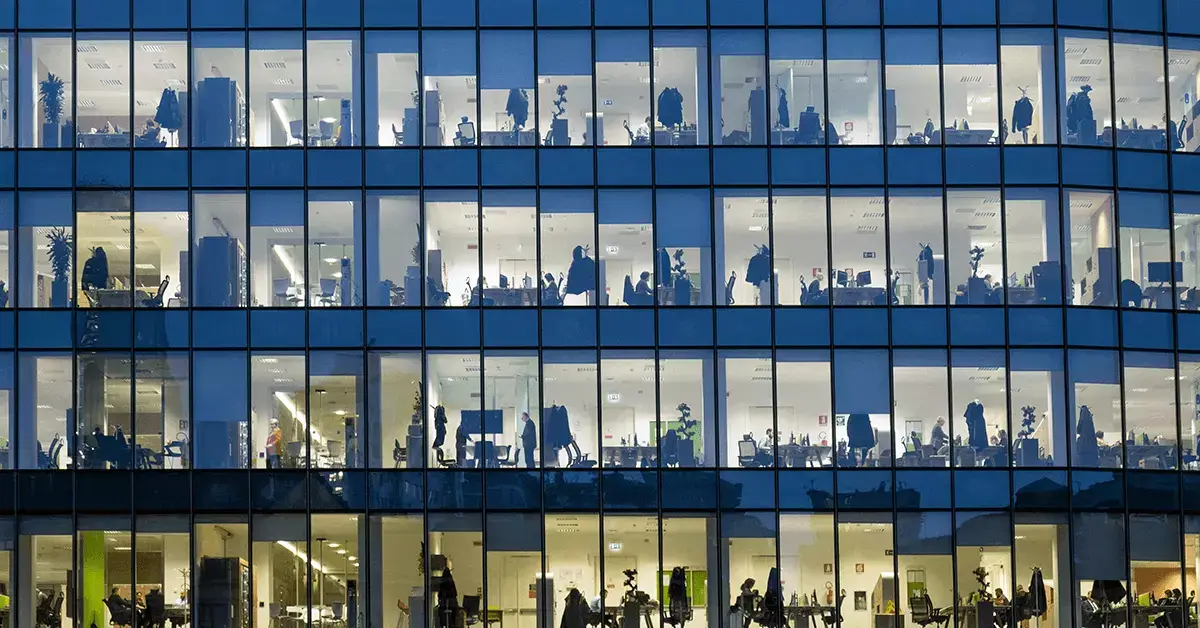First impressions matter, especially when it comes to welcoming first-time visitors and contractors to your site. Providing a seamless and well-organized introduction experience not only sets the right tone, but can also help you enhance the safety, compliance, and efficiency of your business.
Below, we'll look at some best practices, tips, and tools that can help businesses prepare and welcome new visitors and contractors to their site and how a visitor management system (VMS) can help facilitate this.
Clear and effective communication can be the foundation of a successful welcoming or onboarding process. Before visitors or contractors arrive at your site, it is often crucial to verify they are well-informed about the site policies, procedures, and safety guidelines. It may be beneficial to provide them with important information such as site policies, fire evacuation diagrams, health and safety procedures, and site maps. These resources can help familiarize them with the site layout, emergency protocols, and any specific regulations or company standards they need to adhere to.
It's also beneficial to provide check-in and arrival instructions. This may include clearly communicating the designated entrance or area for them to report to upon arrival. If there are any access control measures in place, such as site keys or swipe cards, you should generally make sure they are aware of the process for obtaining these authorizations. By setting clear expectations from the beginning, you can help avoid confusion and allow for a smoother start to their visit or work on-site.
To streamline the arrival of visitors and contractors to your site, it may be beneficial to collect important documents and information from them in advance. Depending on the nature of their visit or work, these documents may include vendors'/suppliers' insurance certificates, compliance documents, permits to work, licenses, and any other relevant certifications.
This proactive approach allows you to review and assess the necessary documentation in advance, helping you make sure any necessary requirements are met before the visitors or contractors arrive on-site. It also gives you an opportunity to address any issues or concerns in advance, saving time and reducing the chance of delays when they arrive on-site for the first time.
For contractors who will be working on your site, having inductions completed before their arrival is a valuable step. Inductions can help provide contractors with essential information about your site-specific requirements, safety protocols, and potential hazards. These sessions can help familiarize contractors with the necessary workplace procedures, equipment usage rules, emergency response plans, and other site-specific guidelines.
Inductions can be conducted through various means, such as in-person sessions, online training modules, or a combination of both. Inductions can also help you verify that your contractors have a clear understanding of the expectations and responsibilities associated with their work on-site. By completing the induction process beforehand, you can save valuable time and more seamlessly integrate contractors into your site operations.
Providing contractors with a thorough induction process helps set clear expectations and empowers them to work safely and efficiently.
Establishing clear lines of communication is beneficial for both visitors and contractors. A visitor management system can help you provide them with contact information for key individuals who can address their queries, provide navigational guidance, and offer assistance during their time on-site. This may include site supervisors, facility managers, project managers, receptionists, or designated site representatives.
Offering readily available points of contact and encouraging visitors and contractors to reach out to these individuals for any concerns, questions, or assistance they may require instills confidence and promotes a sense of support throughout their visit or project duration.
Efficient check-in and check-out procedures can help contribute to a seamless onboarding experience. A visitor management system can empower you to clearly communicate the steps that visitors and contractors need to follow upon entering and leaving your site. For entry, you may provide specific instructions on where they should go - whether it be a reception area, a designated entrance, or a meeting point. You may also inform them about the process of obtaining access credentials, such as check-in at an iPad kiosk or obtaining a visitor's badge.
Likewise, a visitor management system can help you establish and communicate clear protocols for checking-out. For instance, contractors may be required to complete check-out forms to report any site incidents or provide relevant information for documentation purposes. Visitors, on the other hand, can be encouraged to participate in an exit survey to provide feedback on their experience or return site access keys to a designated area or person. These procedures not only help facilitate a smooth departure but also allow you to gather valuable insights and establish more accountability.
Preparing and welcoming first-time visitors and contractors to your site is often a crucial aspect of managing business operations effectively. By following these best practices and utilizing the appropriate tools, you can create a positive and organized onboarding experience.
Clear communication, collecting important documents in advance, utilizing the completion of site inductions, providing key points of contact, and implementing streamlined check-in and check-out procedures can all contribute to a seamless and welcoming environment.
A well-prepared and efficient welcoming process sets the stage for productive collaborations, fosters safety and compliance, and leaves a lasting positive impression on your visitors and contractors.
Welcome visitors and contractors with ease and streamline your site’s inductions and check-in process by embracing the capabilities of a visitor and contractor management system. With a focus on simplicity, efficiency, and a commitment to creating a welcoming environment, Honeywell Forge Visitor and Contractor Management is the ideal solution for preparing and welcoming visitors and contractors to your site.
Visitor flows refer to the volume and movements of visitors throughout and within a building. Key building personnel such as IT managers or facility managers may be interested in monitoring and enhancing visitor flows as it provides valuable data about what is happening on-site. It can also help them a recognize any shortcomings regarding people flow efficiency and space optimization.
A significant part of a visitor's journey when entering a new site is based on how easily they can move around, know where to go, and navigate the building. This is why ensuring seamless visitor flows is such an important part of everyday business operations as these flows can make or break your guests' first impressions of your workplace. Ensuring visitor flows are as seamless as possible can help you create a better experience for not only your guests but also your employees because it helps reduce congestion around the workplace.
Read on to discover some tips on how to create more seamless visitor flows in your workplace.
Achieving seamless visitor flows throughout your building holds an array of benefits. Not only does it allow for more smooth building operations and functions, but it can also enhance your visitors' experience and give them that extra ounce of confidence when navigating throughout your site.
Various factors can help achieve more seamless visitor flows in a building. Adding on, some workplaces may hold different expectations and opinions related around what truly makes consistent people flows. But, the following may be a useful guide for workplaces to follow when considering what generally contributes to a more seamless visitor flow (no matter the scale of operations or industry):

Well-thought-out, concise visitor policies hold an array of benefits to your workplace and its physical security. Office visitor policies allow your employees, managerial staff, visitors, and contractors to understand and acknowledge your workplace rules and expectations. This not only sets the tone of what is required from your staff but allows your visitors to gauge how seriously you take workplace security and the internal operations of your business. When such policies are implemented and scaled, they can help create a more consistent experience for your guests and help you streamline your visitor flows.
Visitor policies can help assist your workplace in achieving more seamless and secure visitor flows in a variety of ways. For this to be achieved, it is important to critically consider what needs to be included in your policy that can help facilitate this.
This may include instructions around where to go and what to do upon arrival, what routes they are required to take to get to their destination, what areas are they allowed or permitted to enter, during what hours are they allowed to visit your site, whether they are required to make an appointment in advance and maybe even what they are required to bring (i.e identification, documentations, credentials).
It might also be advantageous to communicate these policies and procedures to your visitors before they enter your site. This can help give them adequate time to read through and properly understand what is expected from them and what they are allowed/not allowed to do.
For instance, you can communicate to your visitors a map of your workplace and relevant signage they may need to look out for. So, once they do arrive on your site, they know where to go and what to do without the need to wait in line at the reception – helping to reduce bottlenecks and lessening the likelihood of your guests feeling confused or lost.

Everybody in your workplace, from the reception desk up to the C-suite, has a fundamental role to play when creating a positive guest experience and ensuring that all visitors on site are taken care of. As long as these expectations are communicated to everyone in your workplace, this can help create more seamless people flows throughout your site. It helps set the tone for staff around what is expected of them and what they are required to do if a visitor is lost or in a restricted area.
There are various roles and responsibilities you can assign specific staff members, or even just roles that may be relevant to your workplace as a whole. Regardless, this can help aid in creating more seamless visitor flows. Some of these roles and responsibilities may include:

Of course, there is sometimes no better way to enhance the visitor experience than listening to the visitors themselves. Whilst you may have a birds-eye-view of your business operations, it may be optimal to also consider what your visitors have to say about their experiences throughout your site.
As you oversee and walk around your workplace every day, you may begin to develop an unconscious bias which can reduce the likelihood of spotting fresh shortcomings that can interfere with providing seamless visitor flows.
It may be useful to utilize an outsider's perspective as they can point out flaws that you may not have normally noticed. Feedback surveys can be a great way to ask your visitors questions about their experience throughout your site and any recommendations that can make their navigation journey more seamless.
To enable more seamless visitor flows throughout your building, a useful visitor management system should do the following:

Visitors that are returning to your workplace or regular visitors probably won't need to go through the same process or procedures as those who are visiting your workplace for the first time. So, it is important to consider solutions for those that are already familiar with your workplace requirements, have the approvals to enter your site, and are regularly checking in to your site.
For instance, it would not be ideal for those visitors entering your site for the fifth time this month to have to line up behind those visitors entering your site for the first time and have to wait in a congested line to manually enter their details at the iPad check-in kiosk. Not only does it diminish the returning or regular visitor’s experience, but it can also create clunky queues in your reception area that can inhibit seamless visitor flows.
Honeywell Forge Visitor and Contractor Management can help your workplace create more seamless visitor flows by offering robust, digital solutions. Get in contact with our sales team today to learn more.
As supply chain issues persist, inflation rises to a 40-year high, and interest rates increase, commercial and industrial property owners have some tough decisions to make about investments in 2023.
A study of over 250 commercial property professionals by Building Engines and the Building Owners and Managers Association International (BOMA) on the state of commercial real estate (CRE) building operations found that teams are focusing on what they can control in this rapidly changing industry. The current climate has also necessitated doing more and becoming more efficient with fewer resources and less labor.
PwC has also polled CRE insiders and found that they expect 10% to 20% of office real estate stock to be removed or repurposed starting in 2023, meaning landlords will need to do more of what tenants want in a smaller space.
But lean times tend to bring about innovation, which is the foundation of 2023’s commercial office real estate trends. Here’s what we can expect to see more of in the CRE space in the coming year:
Commercial real estate managers and their teams clearly have a lot on their plates this year. Most organizations with properties will likely need to hold onto them (even if they sublet them), partly because it still needs to be determined what role hybrid work will play in the future.
Whether it’s building upgrades, repairs, or regular maintenance tasks, organizations and building managers can’t operate efficiently without creating and managing a work strategy with goals, agendas, and priorities for the coming year. Once plans are in place, companies can onboard various software tools to help manage the work. For example, the global inspection management software industry is expected to grow to over $9.7 billion by 2031.
Then, of course, there are the everyday tasks that need to get done around a building. Completing work orders is the most crucial step towards keeping up with tenants who now expect more from their buildings as prices rise (even when there’s less labor available to get the job done).
Work order management software will be a crucial tool in helping streamline and automate processes, whether designed to assign work orders to an employee, order new parts, or track operation expenses.
According to a survey on The State of Commercial Real Estate Building Operations for 2022 report, tenant experience technology will also see a rise in popularity. Forbes reports that 80% of CRE landlords believe tenants want a mobile app to engage with their buildings, and 64% are increasing their investments in access control technology and visitor management systems.
Sine Lobbies empowers tenants with a cohesive, centralized and secure check-in experience.
Learn about Lobbies
Much construction activity is focused on enhancing existing properties even though a boom in sectors like e-commerce retail has necessitated new buildings for storage. Yet it’s the higher quality of the real estate that many investors have their eyes on since it can help lure tenants into multifamily buildings and bring employees back into the office.
High-quality refurbishments to modernize offices and automate routine maintenance tasks are a major trend for 2023. Modern amenities, more productive workspaces, more privacy, less noise, and new spaces for childcare and dining are all priorities for real estate investors who want to maintain and increase the value of their buildings.
Wellness amenities are another continuing trend in CRE spaces as post-pandemic workers will be more concerned about the workplace’s role in their health. As a result, software like touchless check-ins and the ability to activate contact tracing during public health emergencies may be a good investment.
According to a survey of office workers in the Regenerative Workplace report from JLL, 45% of workers said office spaces geared towards relaxation were at the top of their list of expectations for the future office. Pandemic priorities such as flexible space are still necessary until employers get a better sense of what their office population will be. Still, pandemic needs do pose a challenge for new employee priorities such as comfort, outdoor spaces, enhanced ergonomics, dedicated dining areas, and quiet spaces.

2023 will see increased pressure for greater environmental, social, and governance (ESG) investing disclosure by CRE owners and investors. In 2021, 60% of CBRE’s Global Investor Intentions Survey respondents stated that they had already adopted ESG criteria as part of their investment strategies.
While property certifications like LEED will still be relevant to a building’s environmental performance, new ESG commitments from the EU to require corporate sustainability reporting from more companies will undoubtedly see the appearance of updated guidelines and new mandates.
Energy efficiency is not only an ESG goal but a way to reduce expenses, which makes it an even more attractive prospect going into 2023. This upfront investment will provide long-term payoffs and enhance the comfort of tenants.
Whether CRE owners and investors are looking for tools to reduce energy consumption, improve tenant comfort, or improve indoor air quality standards, there’s a PropTech tool for that. And the bigger a space, the greater its PropTech needs.
PropTech is a large category encompassing tools that can:
As a result of needing new building data, PropTech can help:
A recent JLL report on decarbonizing real estate found that IoT tools for smart buildings have become a priority going into 2023. Only 17% of property teams had PropTech set their sights on these tools in 2022, but that number has increased to 26% (an increase of 53%).
As with other trends, the smart building trend will rely heavily on SaaS platforms to help streamline services and share data. Building management software will need to be robust, but since no single tool can manage every aspect of CRE oversight, that software will also have to play nice with others.
This makes the PropTech economy and API, cloud-based partnerships between CRE companies and software companies another significant real estate trend for 2023. Tools will need to be open, scalable, and vector-agnostic, but investing in these tools will potentially lure workers back to the office and help landlords fill vacancies at higher rents.

A survey of 157 commercial real estate professionals found that 55% believe a recession is likely in 2023, while half are optimistic about the economy. Among their concerns, they identified a lack of affordable housing to help lure workers back to the cities where business headquarters reside as well as supply chain issues. But there is still reason for optimism. One of those reasons – for U.S. businesses – is the Bipartisan Infrastructure Law which will increase spending in the property sector. The $1 trillion bill provides $550 billion in new spending over five years, which will be supplemented by additional infrastructure programs in the Inflation Reduction Act of 2022. Energy-efficient upgrades will be incentivized with credits, meaning things like HVAC systems, heat pumps, and insulation upgrades will be on the docket for offices to provide tenants with comfort, sustainability, improved air quality, and more.
According to the World Green Building Council, commercial buildings account for 40% of global carbon emissions. That means fulfilling promises of a “green” future will have to involve new technologies designed to make buildings more sustainable and useable in order to justify their existence and continue construction.
2023 is the year we’ll see technology enter the building to measure, monitor, and control the systems used by tenants in commercial real estate.
Find out how
Request demo